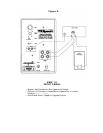Refer to Figure C. Depending upon the setting of the “HIGH PASS SELECT” switch, these outputs
will remove frequencies below 50Hz or 100Hz from your main speakers. This type of hookup cre-
ates a bi-amplified system, lowering distortion and increasing dynamic range.
“LFE IN”/ “BYPASS IN” / KSW 15 ONLY
This input should ideally be connected to a low pass filtered LFE subwoofer output jack on your
electronics. Refer to Figure C. It is typically used with the newest 5.1 (six channel) surround sound
systems. Signals coming into this jack are not effected by the subwoofer’s adjustable “LOW PASS
(HZ)” filter. The “LFE IN”/ “BYPASS IN” input and “LINE IN” inputs are summed together so
both connections may be used concurrently if your electronics provide you with both outputs. The
“LFE IN”/“BYPASS IN” may also be used in conjunction with speaker level inputs.
BASS MANAGEMENT
Most surround sound electronics are equipped with a bass management system that permits the
selection of either a full or limited range (filtered) operation for each speaker, including the sub-
woofer. When using either the subwoofer’s “LINE IN” or “SPEAKER IN” inputs, configure the main
channels of your surround processor for the “Large” or “Full Range” setting. If the subwoofer output
on your electronics has a “non-defeatable” low pass filter, set the “LOW PASS (HZ)” control on the
subwoofer to its highest setting (120Hz). The dedicated LFE input on the KSW 15 is the exception
to this rule. Refer to “LFE IN”/ “BYPASS IN” / KSW 15 ONLY.
The “.1” or LFE (Low Frequency Effects) channel contains a different signal than the bass frequencies
present in the other channels. This information can be up to 10 decibels louder than the bass signals in
the other channels, so caution should be exercised when connecting to this output and initially adjust-
ing the subwoofer's level control.
Operating Controls
“LEVEL” / ALL MODELS
The “LEVEL” control adjusts the volume of the subwoofer relative to your main speakers. Use this
control to compensate for room acoustics, subwoofer placement and the sensitivity of your main
speakers. This control effects the signals that are connected to any of the subwoofers inputs. It does
not effect the volume level of your main speakers.
Suggested control position for initial setup: 10 to 12 o' clock.
“LOW PASS (HZ)” / ALL MODELS
The “LOW PASS (HZ)” control is a variable filter that controls the upper frequency limit of the sub-
woofer. Use this control to compensate for room acoustics, subwoofer placement, type of hookup and
the capabilities of your main speakers. The filter is continuously variable from 40 to 120Hz. Proper
adjustment of this control helps smooth the transition in the bass frequencies between your main
speakers and the subwoofer. Setting the filter too high will cause an overlap in the bass frequencies
reproduced by your main speakers resulting in muddy and indistinct bass. Setting this control too low
may cause the output of the subwoofer to sound disconnected from the bass range being reproduced
by the main speakers. In light of this, we encourage you to experiment with various settings.
If your main speakers are being high pass filtered with an external filter, the “LOW PASS (HZ)”
control on the subwoofer should initially be set near the frequency of this filter.
In some cases, you may elect to feed your main speakers a full range signal. In these situations, the
“LOW PASS” control should be set near the low frequency limit of your main speakers (typically at
the lowest setting of the control with larger, full-range speakers). In all cases, experiment due to vari-
ability in speaker placement, room acoustics and associated equipment.
HIGH PASS FILTERING, SPEAKER LEVEL / KSW 12 AND 15 ONLY
If your speakers are connected to the “SPEAKER OUT” terminals on the subwoofer, they are being
fed a bass limited (high pass filtered) signal. The “LOW PASS (HZ)” control should initially be set
near 100Hz.


















